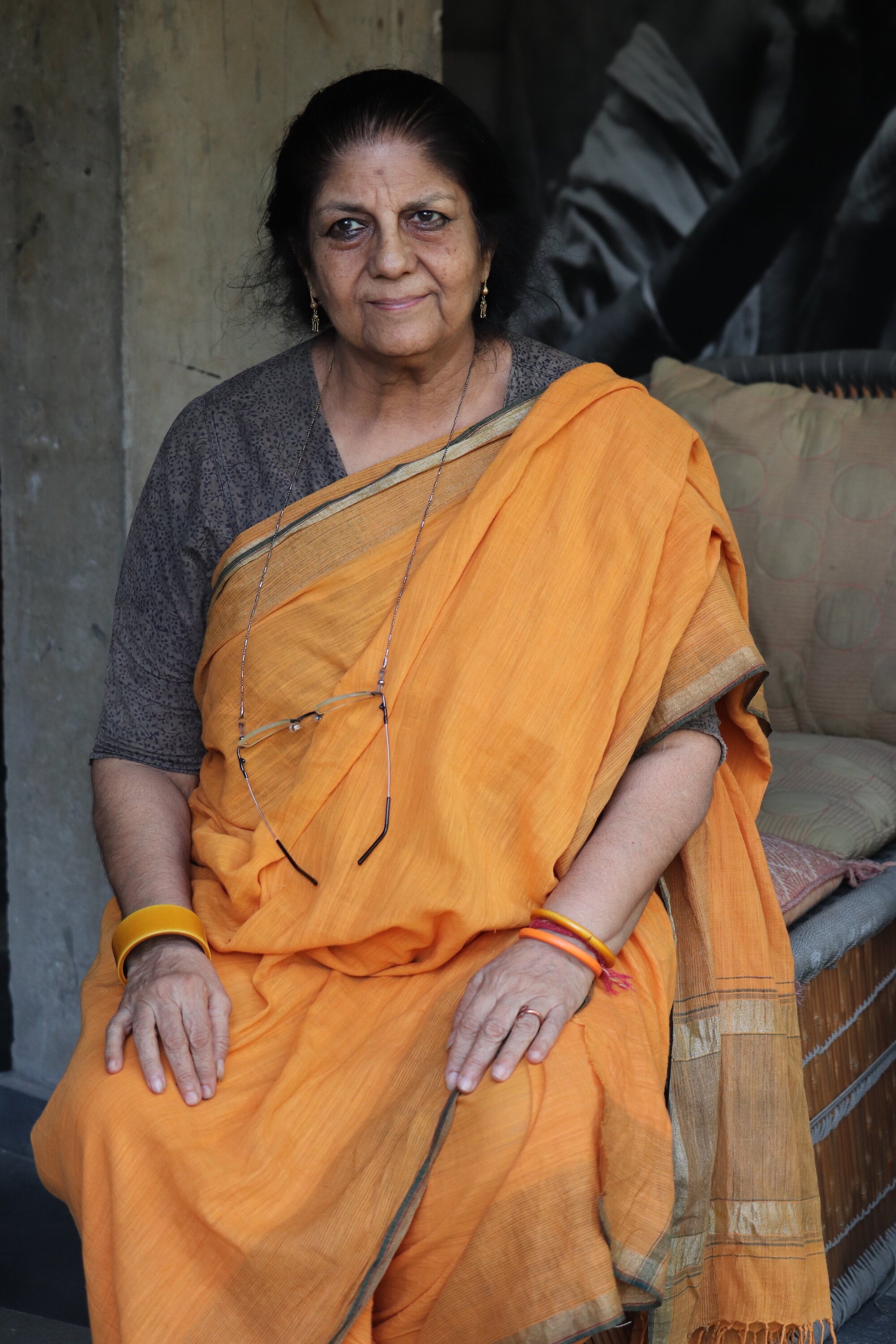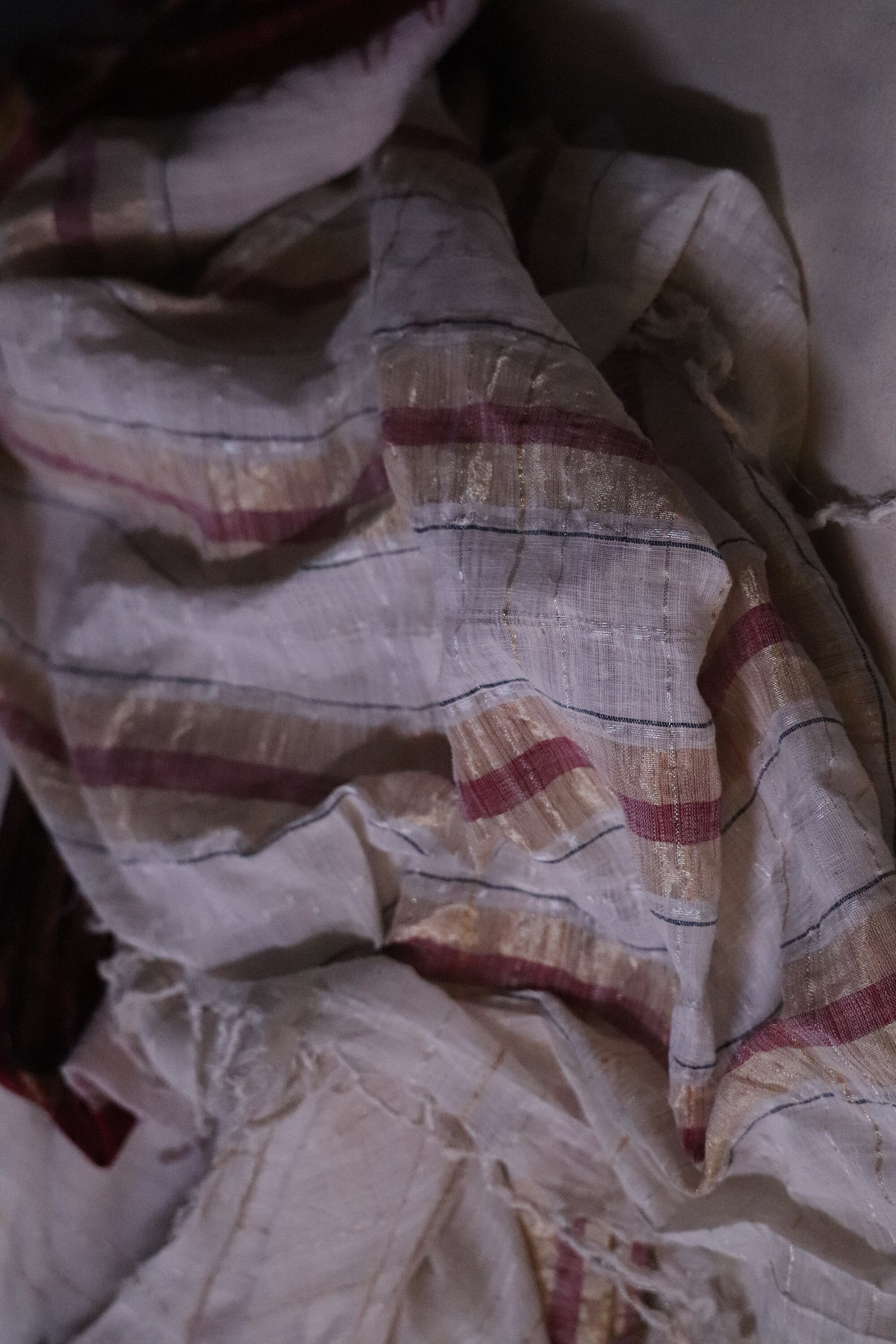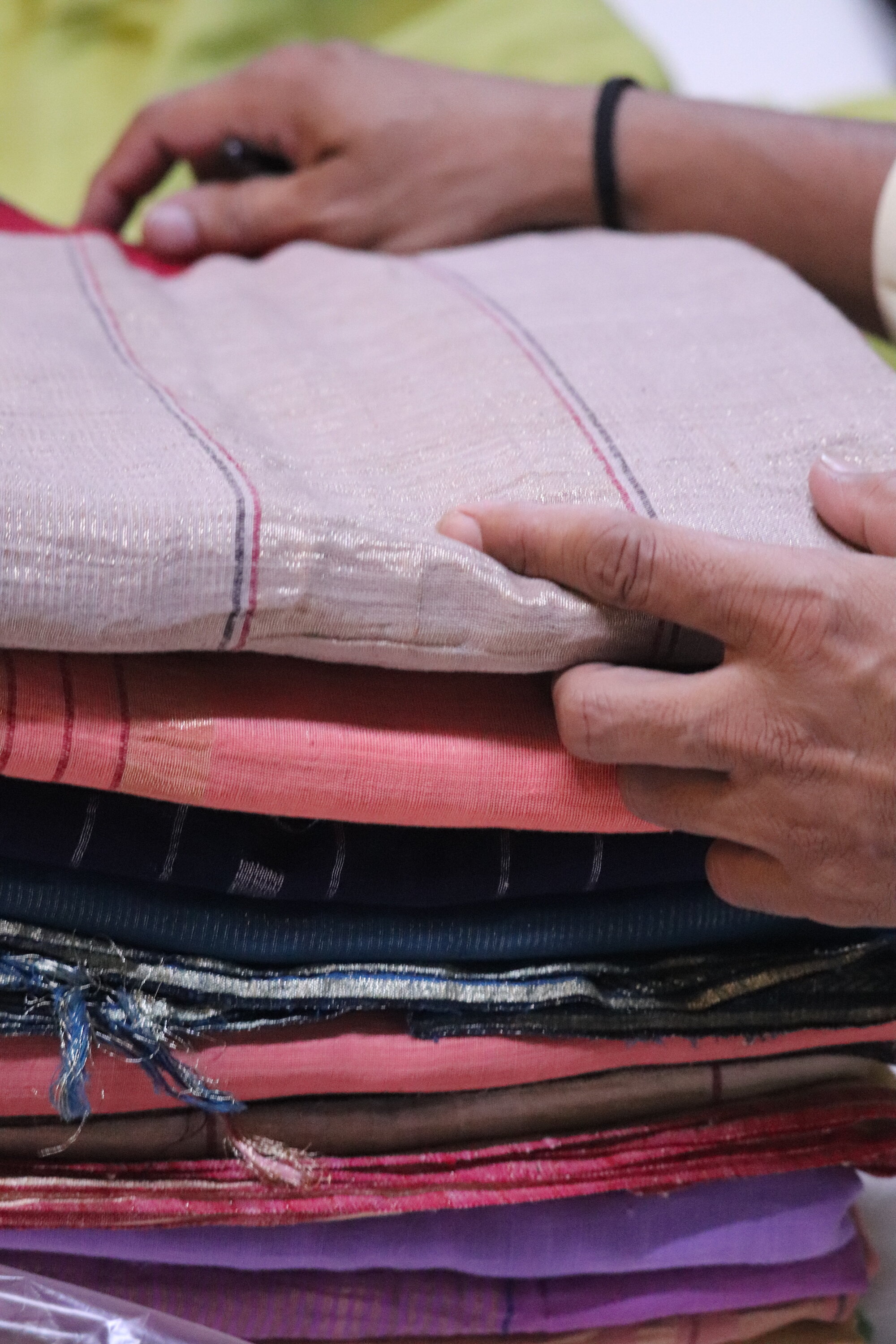Conversation with Rta Kapur Chishti
Rta Kapoor Chisti is a recognized textile scholar, and the co-author and editor of ‘Saris: Tradition and Beyond’ series of books. She is the founder of Taanbaan, a handloom brand that works with indigenous organic cottons and low twist silks. She is a master in the art of draping sarees -- in fact, she can shape it literally in more than a hundred ways.
All images taken by Sayali Goyal
S: I wanted to talk about your journey, from when you first started to what it is now. How do you think the underlying attitude towards handloom and wearing saris has shifted in the last three decades?
I: In the ‘70s when we were in college, if you went in a sari, you had come of age & were chic, whereas today, if you wear a sari to college, you’re considered out of sync. There’s been a lot of interest in the sari in the last 5 to 8 years, but I don’t know how long it’ll sustain.
Western wear has taken over, at least partly, because of the big boom in exports in the ‘70s. Thereafter, everything came out onto the streets. Every city had an export-reject market, for instance, Sarojini Nagar and Janpath in Delhi, and likewise, their equivalents in Bengaluru, Kolkata, Mumbai, Chennai, etc. Children started wearing export-reject western wear bought at very cheap rates. This also matched what we were seeing in the media, on TV, in films, etc., and was another reason for their popularity.
S: I see. Do you see a lot of young people in your workshops?
I: A lot. Some come to see just the silhouettes, others to get the hang of it, and brides who want to wear the sari differently for the various ceremonies. These workshops are not meant for teaching you the traditional way, but more to show you how to do the basics -- the ABCD of it -- and then you go and recreate it for yourself.
S: What are your thoughts on contemporizing the sari? What about experiments with textiles like linen and other materials? Are you someone who believes that it has to be traditional?
I: No, no, it doesn’t have to be traditional. It has to be appropriate for the drape, the occasion, and the material of which the sari is made. Also, once you make it into a stitched garment, it cannot be re-created.
People do wear linen, but I don’t consider it to be very appropriate for this climate. It’s too warm. It’s very good for men’s wear, especially jackets and suits, and more suited to the European spring & autumn, but not for drapes. Also, it crushes too easily, in just two hours of wear, unlike cotton or silks.
S: Are there any craft clusters or textile areas that particularly interest you?
I: We are working in Maharashtra (in Vidarbha), Andhra Pradesh & Uttar Pradesh. There should be many more people working in many more areas. It’s a lot of hard work. I think there has been a sort of restrictive impact because of demonetization as well as the GST, because weavers definitely don’t want to go and hire an accountant for sending their weaves across states.
But there are so many craft clusters that are either on the decline or have suffered because nobody has taken an interest in them. You can see such crafts on the map of virtually every state in the Saris of India series of books. There are so many that I can’t even list them.
S: Everybody is talking about sustainability nowadays. Do you think that textile revival, or specifically saris, can be the answer to cultural, economic, and environmental sustainability? If so, how?
I: We have neglected the organic/desi cottons and the indigenous silks in favour of the hybrids & genetically-modified materials. So much of Chinese and Korean silks, and even wools, have been dumped on us! These are more vulnerable to disease and receptive to climate change, requiring more water, fertilizers and pesticides. And the reason why we have been going for these is actually because they are the ones being funded by the mills. We have to revert to the desi cottons and indigenous silks, and need more people to opt for these. States like Karnataka, West Bengal, Odisha, Jharkhand and Madhya Pradesh have such a rich tradition of this already! The weavers can perhaps be induced if there is financial benefit to match their efforts. If there are enough takers, there will be enough weavers to work with handspun cottons and silks.
S: There’s actually nothing like “pure” Indian culture. Everything is borrowed; we’ve had so many invaders, so many contributors! What do you think is happening in India right now in terms of the design aesthetic? There are so many shifts, specifically in terms of design, because so many people are coming from abroad and using our techniques and materials to create something new. We are also moving out and doing the same. Do you sense a movement?
I: I think that earlier, we were always in a more balanced give-and-take relationship. India was always known as a sort of crucible of textiles, exporting to the rest of the world. For instance, Masulipatnam grew out of more than 300 years of trade interactions. Western wear brought in a certain imitativeness. And now export trade is another story altogether, with its sweat shops and massive scale of production, and the way export rejects flow down to the towns, cities, and the weekly markets in the villages as cheap ready-to-wear. How can you reverse this unless you strengthen the base? I think that hierarchies will always be there, but now the hierarchy itself has become such that the upper classes are wearing things from another culture. Look at what the films are portraying, what the media is promoting, etc. That naturally has a filter-down effect.
S: Right. I see so many people who come to India looking for certain very specific textiles, and they are already so well informed. They want to buy the jamdanis, the muslins, and khadi. Do you think that Indians don’t appreciate these as much? I’m talking more about the masses, not the niches.
I: These were never mass-produced or mass-available textiles anyway. We should not get confused. Khadi was widely produced and worn during the freedom movement (and prior to the British rule) and thus was cheaper. It is more expensive to produce khadi today because the wages for the spinners, especially the hand-spinners, need to be much higher. However, most khadi today is being spun on the semi-mechanised (often with an electrical motor) Ambar Charkha & not on the traditional hand-turned and draw-out one.
S: I feel that maybe because of the key retailers and some designers, including people like yourself, there is an aspiration when it comes to saris nowadays – people want to wear it also because it’s a trend now. When it comes to the price points, do you think that it is important for handloom to be positioned such that it remains aspirational and doesn’t become something for the masses?
I: Yes, it should be kept aspirational, something that you consciously choose, recognizing its value and understanding the effort and skill that goes into its making. There were cheaper versions of saris in each production area including Kanchipuram, Varanasi and many other lesser-known centres, and the finest were indeed expensive due to the materials used, and the aesthetic and technical skills that went into their making. These got levelled out into a sort of middle range as the market expanded. The seven Visvakarma Exhibitions curated by Martand Singh in the 1980s to the early 1990s raised the level of what could be produced to what was best possible at that particular point in time. The producers were affected, and so were the wearers and users. “Khadi – the Fabric of Freedom”, curated by him in 2002-’03, was also an attempt to differentiate the various counts and textures possible in all shades of white to brown undyed cottons with hand processing and spinning up to 100s count, and beyond that up to 450s count by the semi-mechanized hand-turned Ambar Charkha with up to 4 spindles.
S: Let’s move away from textiles a bit and talk about crafts in general. Why do you think material culture is important? How should we look at it? For instance, there are oral historians talking about material culture from about sixty years ago, in the pre-partition era. Textiles and a lot of objects, craft objects specifically, have become these things that have stories to tell and are being passed down through the generations. Why do you think it is important to consume something that’s timeless? Why is it important to invest more in craft or in objects that are not products of industrialization? Because there is always this question of economic sustainability too – industries do employ a lot of people.
I: I think it becomes more precious, more valued, because we have lost it, and are now looking for something that we have lost.
S: Just trying to sort of expand on your point of view, when we buy a leather bag that’s made in Italy, for example, there is a perceived value in our heads. What do you think is the perceived value of ‘Made in India’ outside of India?
I: Not in the same way as Italy has been able to. Creating an identity as Italy consciously did in the ‘50s and the ‘60s needs a more committed and serious approach to materials and techniques.
S: Still, do you think things are moving? There are so many Indian designers who are moving out and retailing out of Europe and the Americas. Do you think a shift is happening, that the value of ‘Made in India’ may be increasing?
I: They are not selling Indian brands; they are selling western wear for the Western market at cheaper rates compared to other Western brands.
S: I am not talking about the masses. I am talking about, say, Good Earth, which has two retails stores outside of India. I know Nicobar does a lot of stuff outside. Raw Mango did a number of trunk shows this summer in the US. And there is a huge demand specifically for the sari. Do you think that perceptions are changing?
I: Possible. It’s possible. But I can’t say if it will sustain, or how long it will last.
S: Do you think that the sari is just a trend then?
I: Yes, it could be a short-lived trend, because everything in the West changes so fast – their interests change in a blink.
S: What do you think of oft-used adjectives like ‘conscious’, ‘organic’, ‘sustainable’, ‘slow’ and ‘handmade’?
I: We are too late in the picture for this. We are trying to achieve in 70 years what took the world 250 years. I don’t think we can industrialize at the frantic pace we are doing now without very big side effects. And maybe China can’t do it either in the long run, unless it remains a completely controlled system. All the problems of pollution, contamination, climate change and other ecological concerns are the by-products of industrialization happening too fast. So you must, for your own good, revert to a slower mechanism (or shift to another planet!), and only the very well-to-do may be able to do this.
S: Right. But I see that it has almost become a trend to use these labels.
I: I think people do that for better sales. They may not all be genuine. But you know -- who can really check that -- unless the producer base is conscious of it?
S: I wanted to ask about the underlying objective of your work – of your books, your anthology, and your workshops. Is it just to take the sari ahead, or does it concern larger things, like textiles, handloom, and culture?
I: It’s all of them, yes. It’s a rediscovery of what is possible. If you go at a slower pace, if you want to recreate something contemporary, how else would you do it, except by getting your raw materials right first, then actually processing them, and then the techniques to be used for hand weaving? Only then could you hope to make better fabric.
The hand-woven sari provides vital clues to better fabric structure for any kind of use -- whether it be for draperies, or garments, or home furnishings -- as it combines variable densities of fabric in the body, borders and the end pieces (pallus) of the sari. These densities create at least double the weight in the borders, not only by increasing the number of threads in the warp, but also because of the warp and weft-patterning techniques employed, and four or five times more weight in the end pieces. for a three-dimensional draped garment that should not need further support by attaching a fall or piping at the points of greater wear and tear such as the ankles or waist.
S: So what’s most interesting for you in this whole process? Is it the anthropology around it -- what your articles say about how every state has its own way of wearing the sari, and how that says something about the community and its identity? Or is the handloom story -- the textile story?
I: I think my work is about bringing all of this together; there is no separating them or keeping them apart. Urbanization at first made us want to forget where we came from, and the most common urban wearing style was initiated by Gyanodanandini Tagore in the 1860s. But today, in the early 21st Century, when the choice is between a total switch to western wear (which is not particularly complimentary to our body forms, nor suited to the climate) vs. the recreation of the sari in innumerable ways to suit different functions, weather, personalities and materials, we could take a great leap forward in terms of originality.



